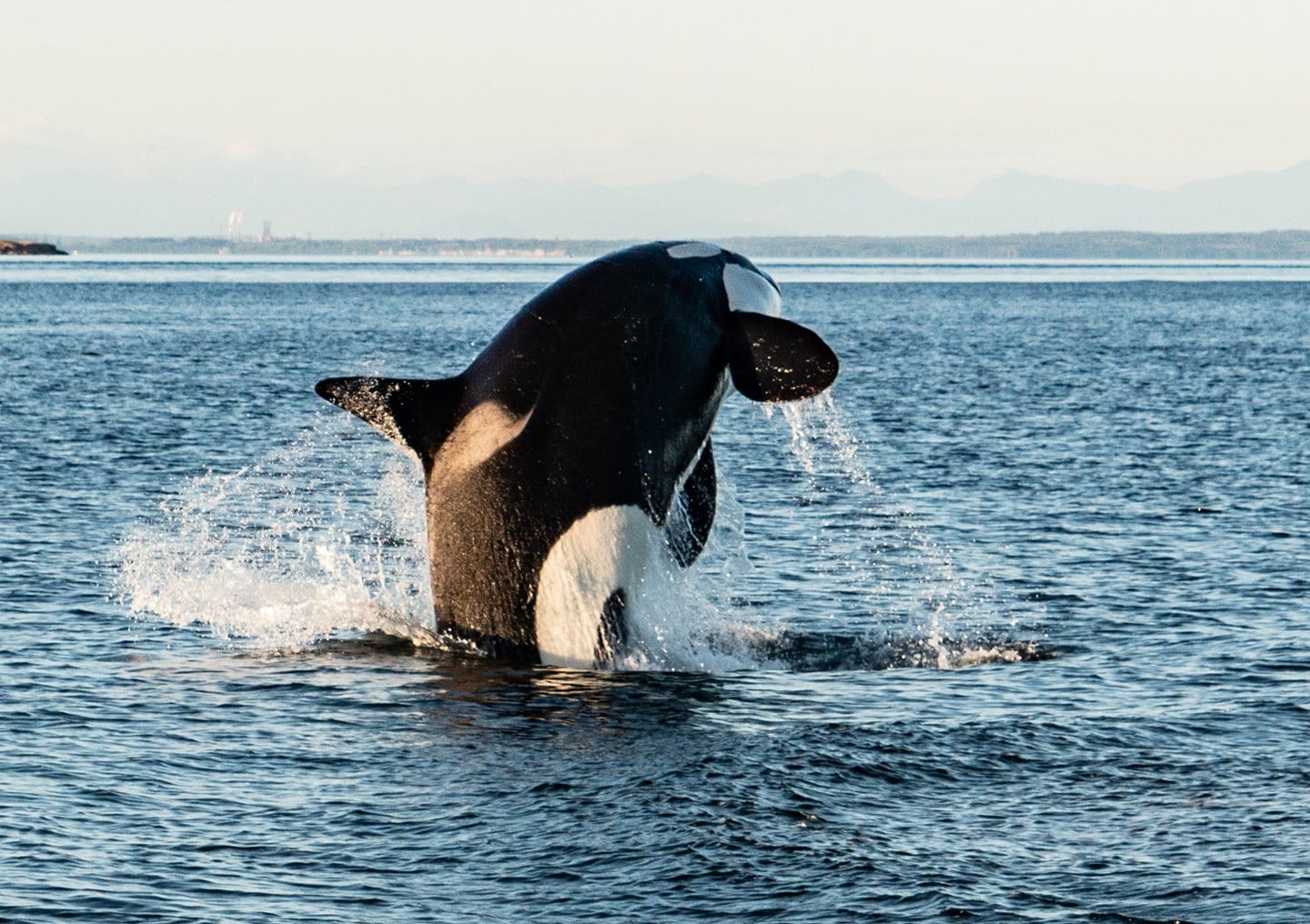This was a year like no other with the COVID-19 pandemic delaying the start of the Victoria whale watching season until July. With international borders closed, Victoria was a quieter place with only tourists from across Canada visiting our Capital City.
While the world seemed up-side-down on land, time on the water and with wildlife felt unchanged. Whales still surged through the darkness of the deep and sea lions continued to bark and growl. Ollie the Sea Otter still spent time napping in the Bull Kelp beds while seabirds carried on raising chicks and diving for small fish to feed hungry mouths.
July – Familiar Tails & Bigg’s Killer Whales!
The start of the Victoria whale watching season brought consistent sightings of Humpback Whales and Bigg’s (Transient) Killer Whales in the Juan de Fuca Strait. Scuttle may have been the humpback we saw most often this season. Scuttle is one of the easiest humpbacks to ID because of the distinct scars on their tail. Scuttle has survived at least one attack from mammal-hunting killer whales and there are wounds of war all over their tail.
AUGUST- Breaching Yogi and Orca-Palooza!
August started with a BIG splash! Yogi, a humpback known to be very active above the surface, left us speechless when he breached over and over again on the afternoon of August 2nd. Between breaches, he showed off his fifteen-foot pectoral fins by hugging the sky before slapping them down on the water. It was an amazing sight to see such a huge whale launch itself out of the water!
We can ID this family very quickly once they have been spotted thanks to Galiano’s gigantic dorsal fin! His fin is so wide from bottom to top that it leans to the left. Then we look for the tall, straight, and pointed dorsal fin of his younger brother Spouter.
It is unclear whether he is leucistic or if he has Chediak-Higashi Syndrome. Leucism causes a lack of pigment in some cells but is not life-threatening. Chediak-Higashi Syndrome is an auto-immune disorder and individuals of any species with this disorder often die before the age of five. Scientists continue to monitor this young whale and hope to determine exactly what has caused him to have this unique pigmentation.
September- Southern Resident Babies!
The endangered Southern Resident Killer Whale population holds a special place in all our hearts. Historically, they are the population of whales that we see most often, but due to a severe lack of Chinook salmon in the Salish Sea, they have been less present for the past several years. With the population threatened by extinction, every birth is a precious glimmer of hope for their future. You can imagine our excitement when two babies were born in September!
On September 5th, J-pod was off the shores of San Juan Island while K and L pods were traveling towards them from the west where we were watching them. The Center for Whale Research reported a new calf (J-57) in J-pod belonging to Tahlequah (J-35)! K and L pods were coming in to meet the newest member of the population.
Tahlequah became known to people around the world in 2018 because her newborn calf at the time only survived for about 30 minutes. She proceeded to carry her calf on her head for 17 days and over 1000 miles. That summer was marked with heartache for the population, but we are all very hopeful that the birth of this new baby will begin a new chapter for Tahlequah, her family, and the entire Southern Resident community. A few weeks after first being spotted, little J-57 breached out of the water and revealed that we had a boy!
Our most exciting and memorable trip of the Victoria whale watching season happened on September 24th when guests and crew witnessed the birth of J-58! Close to Race Rocks Ecological Reserve a lone Southern Resident Killer whale was spotted, which was out of the ordinary as they typically travel as a tight-knit group.
The naturalists were able to identify this whale as Eclipse (J-41) who is 15 years old. We watched her surface a few times, then she spent a long time underwater. When she finally surfaced, she was not alone- she had a brand new baby with her! Guests and crew witnessed this J-58’s very first breath, it was an extremely rare and special moment for everyone.
This new baby brings the Southern Resident population numbers up to 74 members. We are cautiously optimistic for the future of the Southern Residents as we strive to help increase the populations of Chinook salmon so that this population can support new calves and thrive in the Salish Sea.
So many other fantastic species of wildlife are part of our whale watching tours including Harbour and Dall’s Porpoises, Steller and California Sea Lions, Ollie the Sea Otter, Harbour Seals, Elephant Seals, Bald Eagles, and many species of marine birds. We even see non-native species like Mouflon Sheep, Sika Deer, and Fallow Deer when we travel the waters around Spieden Island.
All this diversity creates amazing opportunities to witness wildlife in the Salish Sea. We love to listen to the growls and barks of the sea lions and drool over the cutest of Ollie. We are very fortunate to be able to take guests to see all these different species of animals with the stunning background of the Olympic and Cascade Mountains and rugged shorelines of Vancouver Island, and the Gulf and the San Juan Islands.
The Victoria whale watching season was full of excitement and together we made unforgettable memories. We had a spectacular summer and fall on the Salish Sea with the whales and other marine wildlife. We are so grateful and look forward to the adventures that the 2021 whale watching season will bring.
Until next summer, you can experience the wild on a Winter Wildlife Tour departing daily from Victoria. We hope you can join us!









